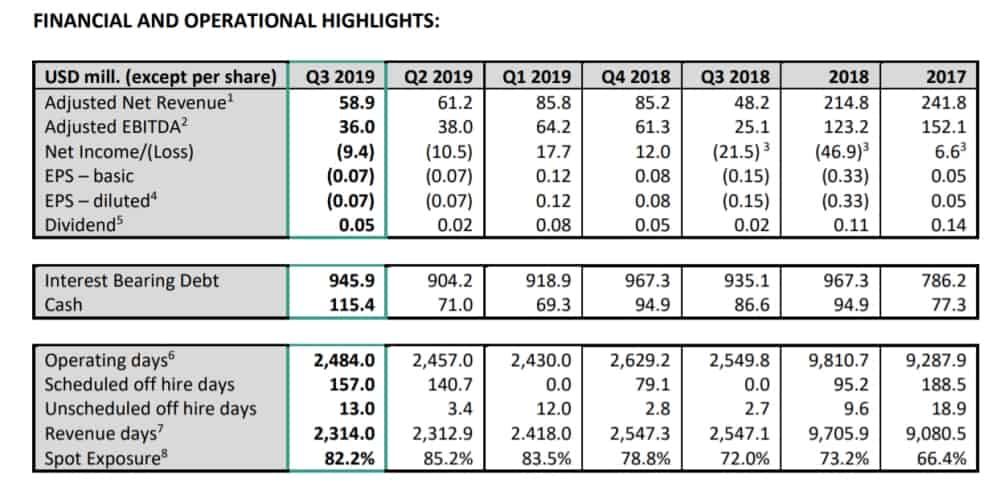If you want to know what actually happened during the recent crude-tanker maelstrom, when rates were briefly assessed at over $300,000 per day, there’s no better person to ask than a top executive of DHT Holdings (NYSE: DHT).
DHT is a pure-play owner of very large crude carriers (VLCCs, tankers that carry 2 million barrels of crude oil each). It’s one of the owners that had VLCCs positioned in the Middle East to vie for the highest rates during the recent spike. Its executives just happened to be in direct discussions with Asian refiners – the shippers of the VLCC cargoes – at the exact moment rates skyrocketed. And DHT is publicly traded, so its executives will actually tell their tale, not keep it to themselves.
That story, of what DHT execs referred to as “the frenzy,” came out Oct. 24 during the quarterly earnings conference call with analysts.
The spark
“It started with the firming in the market in September,” DHT Holdings co-CEO Trigve Munthe explained. “There was clearly increased demand from refineries and deliveries of newbuildings were slowing down, so we had basic fundamentals in our favor and rates coming up to around $40,000 a day.”
DHT co-CEO Svein Moxnes Harfjeld added, “What happened later would not have happened unless you had these very strong fundamentals as a platform. In a market that was off balance, it wouldn’t have happened.”
The big trigger was the U.S. sanctions against the Chinese tanker owner COSCO (Dalian) on Sept. 25. According to Munthe, “When the COSCO sanctions hit the market, that certainly put everything on fire. Part of the reason was how the Chinese, including Unipec [the world’s largest tanker charterer], reacted. They immediately abandoned their COSCO fixtures and scrambled to get replacement tonnage.”
When the market reached its apex on Friday, Oct. 11, “The charterers really panicked. The biggest numbers were done on that Friday, and then over the weekend, people got their pulse back down to the normal range again and things calmed down. You started to see those fixtures fail and replacement fixtures done.
“In the frenzy, most of the deals with spectacular returns of over $200,000 or $300,000 a day failed. The best figure we did that was a real transaction was about $190,000 a day,” he confirmed.
Back to earth
In the two weeks since that peak, “things have calmed down and the activity is lower,” Munthe continued. “The charterers are back to their typical tactic of drip-feeding cargoes into the market to try to make the [ship] owning fraternity nervous. But even so, we are now at levels of just under $100,000 a day.”
The ultra-high $300,000-a-day rates that made headlines Oct. 11 were not feasible from the perspective of the refiners that book the cargoes, he added. “It turned out that those rates weren’t doable. When you get to that kind of freight level, you make it very hard for the refiners to make money. In that crazy week, we happened to be in Korea meeting with a lot of refiners, and they told us that at those freight levels, it just didn’t make sense for them. They said they would just pull back on their [refining] throughputs and start trading their time-charter ships [in the spot market].”
Earnings lag effect
The comments by the DHT executives on the historic VLCC rate rise coincide with the reporting of earnings by tanker companies that will post either low profits or losses, because there is a considerable lag between spot rates and quarterly returns.

DHT reported a net loss of $9.4 million for the third quarter of 2019 versus a net loss of $21.5 million in the same period last year. It reported an adjusted loss per share of $0.06 in the most recent period, in line with the analyst consensus forecast.
The company’s VLCCs earned an average of $25,500 per day in the third quarter, with its ships on time charter earning $33,700 per day and those on spot earning $24,300 per day.
The real surge in VLCC spot rates has come in the fourth quarter. As of Oct. 24, DHT had booked 49% of its available spot days for the fourth quarter at an average rate of $61,700 per day. Many of these voyages were booked in the prior quarter when rates were lower. The remaining 51% of spot days should earn much higher rates given current levels.
Munthe explained, “There is a time lag effect. At the start of any quarter, a lot of the fixtures are done in the preceding quarter, so in a rising market the initial reading [for the quarterly average] will be lower than the final reading.”
VLCCs: Very Large Cash Creators
“We believe we are in the early innings of an exciting bull market for tankers,” Munthe said. “The recent frenzy was short-lived, but we have now settled at rate levels that far exceed even the most optimistic rate forecasts we had seen for this winter.
“In a $100,000-a-day market, DHT stands to generate over a dollar per quarter in earnings per share [EPS]. Each $10,000 [per day in spot earnings] translates into $0.15 in quarterly EPS,” he said, describing the current level of just under $100,000 a day as “a fantastic rate.” As Munthe put it, “In these kinds of markets, VLCCs become ‘Very Large Cash Creators.’” More FreightWaves/American Shipper articles by Greg Miller









